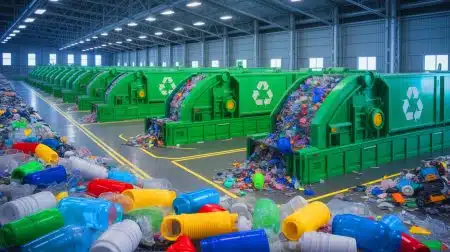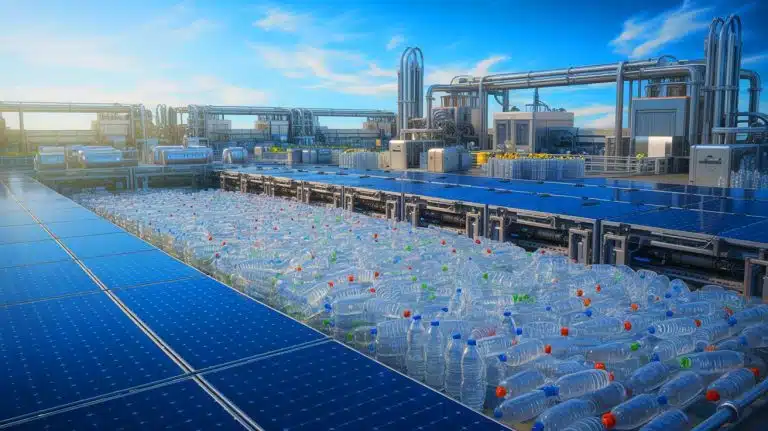| IN A NUTSHELL |
|
Recent innovations in recycling technology have the potential to turn one of the world’s most persistent waste issues into a significant energy solution. Scientists at the Institute for Basic Science in South Korea have developed a groundbreaking system that transforms plastic waste into clean hydrogen fuel using sunlight, offering an eco-friendly alternative to traditional hydrogen production methods. This new approach not only addresses the environmental challenges posed by plastic waste but also contributes to the growing demand for sustainable energy sources.
Understanding Photocatalytic Hydrogen Production
The concept of photocatalytic hydrogen production is gaining traction due to its potential to utilize sunlight as a clean energy source. However, this method faces significant challenges, particularly in maintaining stability under intense light and chemical stress. To overcome these hurdles, South Korean scientists have engineered a unique system that stabilizes the catalyst within a polymer network. This innovation places the reaction site at the critical interface between air and water, enhancing the system’s efficiency.
This innovative setup allows the system to sidestep common issues such as catalyst loss, inadequate gas separation, and reverse reactions. By breaking down plastic bottles into byproducts like ethylene glycol and terephthalic acid, the system releases clean hydrogen into the atmosphere. Notably, the system has demonstrated stability over two months, even in highly alkaline conditions, proving its robustness in various watery environments, including seawater and tap water.
The Potential of Scaling Up the Plastic Waste Recycling System
Plastic bottles are a significant contributor to global waste, with billions discarded daily. The development of a system that converts these bottles into a clean hydrogen source addresses both waste management and energy production challenges. The scalability of this system is particularly promising, as simulations indicate its potential to expand to 10 or even 100 square meters. This expansion could lead to cost-effective, carbon-free hydrogen production on a larger scale.
Professor Kim Dae-Hyeong highlights the transformative potential of this research, stating that it opens new avenues where plastic waste is seen as a valuable energy resource. Professor Hyeon Taeghwan adds that this work represents a rare example of a photocatalytic system functioning reliably outside the laboratory. The scalability of this system could significantly contribute to the goal of a hydrogen-powered, carbon-neutral society.
The Environmental and Energy Implications
By integrating waste management with energy production, this innovative system addresses two critical global issues simultaneously. The production of hydrogen from plastic waste not only reduces the volume of plastic entering landfills and oceans but also provides a sustainable energy source that mitigates the environmental impact of traditional hydrogen production methods. This dual benefit underscores the potential of the system to contribute to a cleaner, more sustainable planet.
| Key Benefits | Details |
|---|---|
| Waste Reduction | Converts plastic waste into useful byproducts |
| Sustainable Energy | Produces clean hydrogen fuel |
| Scalability | Potential to expand production areas significantly |
Looking Forward: The Future of Clean Energy
The potential applications of this technology are vast, offering a glimpse into a future where waste and energy challenges are addressed concurrently. As global energy demands increase, the need for clean and sustainable solutions becomes more pressing. The development of photocatalytic hydrogen production systems provides a promising pathway toward meeting these demands while improving environmental outcomes.
As the world grapples with the dual challenges of managing waste and meeting energy needs, could the widespread adoption of such innovative systems be the key to a more sustainable future?
Did you like it? 4.6/5 (29)







Wow, this sounds like a game-changer! How soon can we see this tech in action globally? 🌍
Are we sure this system is safe for the environment? Sometimes new tech has hidden downsides.
Finally, a solution to both plastic waste and clean energy! Thanks for sharing this incredible news! 😊
Is there any info on the cost of implementing this system on a large scale? 💰
Does this mean we can turn our trash cans into hydrogen stations? 😂
Great news! But how efficient is this system compared to traditional hydrogen production methods?
Is this tech already being used anywhere in South Korea, or is it still in the testing phase?
Hope this doesn’t turn out to be another overhyped green tech. 🤔
How long before this system can be scaled to serve entire cities?
Loving the innovative approach! Can it handle all types of plastic waste?
Sounds too good to be true. What’s the catch? 🤨
Plastic to hydrogen? That’s some next-level recycling magic! ✨
I’d like to see more real-world data before getting too excited.
Great to see South Korea leading the way in clean energy solutions! 🇰🇷
Is there a risk of other harmful byproducts being released during the process?
I wonder if this tech could work in less sunny parts of the world. 🌧️
Thanks for the article! This gives me hope for a cleaner future.
Are there any potential geopolitical implications of widespread adoption of this tech?
Can this system handle mixed waste, or does the plastic need to be separated?
Yay for science! But what’s the energy input vs. output ratio? 🤓
Finally, a practical use for all those plastic bottles! 🍼
Seems like a perfect solution, but how do we deal with the scale of global plastic waste?
Hope it’s not too expensive to produce on a mass scale. 🤞
Could this tech be used for industrial waste too?
Great initiative, but what about the environmental impact of the catalysts used?
Hydrogen from plastic using sunlight? This is straight out of a sci-fi movie! 🌞
How does this system compare to other renewable energy sources like solar panels?
Does this mean we’ll never run out of hydrogen fuel as long as there’s plastic waste?
Can this be integrated with existing waste management systems easily?
Yesss!!! Less plastic in oceans, more clean energy. Win-win! 🌊
Would love to see this in action! Any demo videos available?
I’m skeptical. Sounds like it might be more complex than it seems.
Is there a possibility for local communities to build smaller versions of this system?
Can this technology help reduce reliance on fossil fuels significantly?
Amazing potential here! What are the next steps for development? 🚀